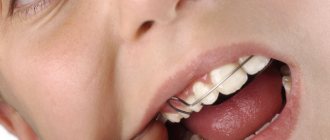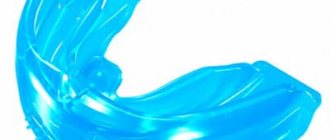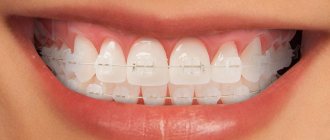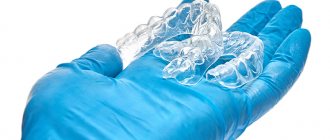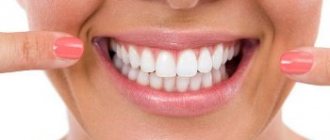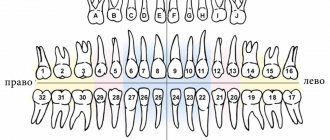Trainers for teeth is a type of myofunctional corrector that is used to correct bites along with classic plates and braces that are already familiar to everyone. The main feature of trainers is that they not only remove the consequences - they correct incorrectly formed teeth, but work with the cause: they help develop the jaw muscles, remove excess pressure on the bones, form correct nasal breathing, and tongue position. That is why this method of treatment is considered more promising.
Indications for the use of dental trainers
A dental trainer is usually prescribed to be worn in the following situations:
- a person cannot have braces installed for one reason or another;
- the bite has formed incorrectly;
- swallowing is impaired;
- teeth are displaced;
- often stuffy nose due to problems in the oral cavity;
- complexes or profession do not allow wearing other systems;
- there are speech therapy problems, etc.
Sometimes, if a doctor sees that a patient is at risk of malocclusion, he will prescribe a dental trainer as a preventive measure.
Read in detail about problems with bite here: All about bite: what it is like
results
This orthodontic device helps to cope with problems such as:
- mesial bite – the lower jaw is pushed forward;
- distal bite – the upper jaw protruding forward;
- open bite – non-occlusion of the front or side teeth;
- deep bite - the upper incisors overlap the lower incisors by half or more;
- crowding of the lower front teeth - the position in which they overlap each other;
- speech problems caused by abnormal position of teeth; improper swallowing.
The dental trainer also helps to get rid of mouth breathing and bad habits: sucking fingers or foreign objects, inserting the tongue between the teeth.
It is worth noting that trainers are not able to cope with complex cases of malocclusion. We are talking about complex problems - a combination of several anomalies listed above.
Who should not wear trainers?
The systems described are primarily medical devices, so if you are impressed by the various photos before and after the trainer and want to buy such a device for yourself, be sure to consult with your doctor. Self-treatment with a trainer is dangerous and can cause harm.
There are other situations when it is better to choose another treatment option:
- if there is nasal congestion, which has become chronic (the patient simply will not be able to train at full strength, because he will have breathing problems);
- when the bite of the teeth in the lateral areas is cross;
- if a trainer is chosen for a child , but the child is uncontrollable and does not obey his parents (classes must be on schedule, otherwise there will be no effect).
In the described cases, it is better to use braces to correct a malocclusion.
Pros and cons of treatment with trainers
Why are dental trainers for adults and children so popular? This system has many advantages that make it popular and convenient. The main advantages of treatment using such structures:
- low price. The most budget trainer is very cheap, and modern improved models still cost 3-4 times less than an inexpensive brace system;
- ease of care. The patient does not require any special cleaning products or devices - just toothpaste and a brush are enough;
- versatility. The trainer does not need to be made specifically taking into account the patient’s characteristics; you just need to choose a model by size;
- wearing does not have a negative effect on the enamel or soft tissues, the devices do not injure the tongue or gums;
- In addition to bite, trainers also solve other problems, for example, correcting speech (in cases where diction problems were caused by incorrect dentition);
- the patient experiences minimal discomfort while wearing.
An additional advantage of trainer systems is that they do not cause any psychological discomfort: the trainer can be removed at any time to eat, drink or go to an important meeting. However, this method of changing the bite also has its disadvantages:
- slow effect. You need to wear the trainer for at least a year to see real results;
- prohibition on eating and drinking while wearing. If you take a trainer for a child , this can become a serious problem;
- Treatment must be carried out strictly according to schedule and for the required amount of time per day, otherwise there will be no effect. This option is only suitable for responsible people, and children should be supervised by parents.
Trainer effect: before and after
Price
These devices are not an expensive pleasure and almost anyone can buy them. The average cost ranges from 2000 to 6000 rubles .
This significantly distinguishes the designs from brace systems, which are many times more expensive, especially those made of expensive materials or invisible to others.
The price depends on the number and cost of orthodontic consultations and the cost of the trainers themselves.
With the help of these devices, it is easy to correct malocclusions; it is important not to delay the start.
Types of dental trainers
Modern trainers for teeth straightening are classified according to different criteria. There are soft models, products of medium and high hardness. Each type is created for its own case. For example, an initial trainer is a soft structure that is used for treatment in the first stages, and a retainer is a model that allows you to consolidate the results of previous treatment. Let's look at the most popular types of trainers for dentition correction.
Pre-orthodontic children's trainers
Dental trainers for children are called pre-orthodontic and are used on the primary dentition. They are divided by age: for small children it is recommended to buy the Infant model (4-6 years old), for children from 6 to 10 years old there is already a more adult model - T4K, which takes into account the change of milk teeth to permanent ones.
Trainer Infant
A children's trainer is sometimes used even if there is no malocclusion. It is prescribed in the following cases:
- mouth breathing;
- increased tone of the temporomandibular joint;
- bad habits that negatively affect the dentition (for example, thumb sucking in your sleep);
- asymmetrical teething, etc.
The first trainer - the initial one - is made of soft silicone, which adapts to the child’s oral cavity. It is left overnight and used for 8-9 months. The second trainer – therapeutic – has a rigid frame and is installed for a year or more. Sometimes a child has to wear the system until he is two years old.
There are also special children's dental trainers that help avoid malocclusion in the event of early loss of primary incisors, canines, and molars. They are prescribed from the age of 3 years for the entire period while permanent teeth are being cut.
Finish Trainers
A final orthodontic dental trainer or retainer is usually prescribed for adolescents between 10 and 13 years of age. It is used for several purposes:
- consolidate the result after treatment with braces or other methods;
- allow weakened enamel to recover faster by protecting it from bad habits;
- form correct swallowing, reduce increased tone of the facial muscles.
Doctors often use a finishing type trainer to correct the not entirely correct position of teeth after unprofessional installation of a brace system.
Finish Trainers
Joint trainers
A joint trainer or joint splint is a device that reduces or eliminates pain due to dysfunction of the temporomandibular joint (TMJ) and relaxes tense muscles of the face and neck. At the same time, it also protects your teeth if you or your child have a habit of grinding them in their sleep.
Thanks to its arc shape, the articular trainer corrects the position of the lower jaw, and the soft material allows the device to easily adapt to any characteristics of the patient.
Joint trainer
Trainers for braces
A trainer for braces is a special type of medical device. It allows you to combine the stages of instrumental and functional treatment, increasing the effectiveness of both approaches. As a result, the result of treatment with braces becomes more stable, and the process itself goes faster.
Benefits of wearing a braces trainer :
- helps relieve muscle pressure;
- protects the oral cavity from damage from braces during the night;
- eliminates bad habits, which reduces the risk of re-developing dental problems.
Examples of such devices can be viewed in our catalog: Trainers for braces
Trainer for braces
Trainers for adults
Trainers for adults are used less frequently, but are also quite popular. The structure of the models is very similar to teenage ones, but a little more complicated. A standard hard trainer for an adult consists of the following elements:
- lip bumper, which reduces the tone of the facial muscles;
- a central stop that sets the correct position of the tongue;
- enlarged lateral edges, due to which the temporomandibular joint is supported.
Products are also divided by hardness: at night a soft model is used, and during the day it is recommended to train with a hard one.
An additional advantage of trainers for adults is that they successfully combat snoring.
Trainer for adults
General overview
From a technical point of view, trainers belong to the category of devices that train the muscles of the jaw apparatus by creating the effect of mechanical load. Directed pressure allows you to correct the pathological vector of development, restoring the natural anatomical position.
The I3 trainer is developed by MRC, a company based in Australia. The device is intended for the correction of malocclusion development in the third degree, for which a characteristic feature is the medial displacement of the lower molars of the first group in relation to the upper elements. The upper jaw protrudes noticeably above the lower jaw, which causes aesthetic and physiological discomfort for the patient. Timely treatment begins increases the likelihood of achieving the desired result.
Why trainers are better than other orthodontic devices
Compared to other orthodontic devices, teeth straightening trainers benefit in three ways:
- They do not need to be worn constantly like braces. Therefore, you don’t have to limit yourself in communication or refuse to work with people. At school, children will not suffer from ridicule from classmates;
- they do not put pressure on the teeth. Braces and plates affect the teeth, destroying the enamel and injuring, irritating the mucous membrane;
- they are much cheaper and do not require individual production. The patient can buy a trainer in a store (for example, choose it from the catalog on our website) and immediately start wearing it.
Another plus is that you don’t have to wait for the trainer to be made. All you need to do is ask your doctor which model and size you need, and order it in the store. This is also different from braces, the installation of which takes a lot of time.
Prices
The cost of dental trainers is quite affordable - from 2,500 to 6,000 rubles. Consultations with orthodontists are paid separately, the cost differs depending on the pricing policy of the clinic (on average from 500 rubles).
It is important to note that you should not expect a miracle from treatment with trainers. These structures are not able to cope with complex occlusion pathologies, which can only be cured with devices that exert strong mechanical pressure (braces and plates).
It makes sense to wear trainers only if prescribed by an experienced doctor, who will determine all the features of dental anomalies and consider that trainers will cope with these anomalies. You can find such a qualified orthodontist in the database of dental clinics on our website.
How to put on and wear a trainer correctly. How long does it take to get used to
Adult and children's dental trainers are put on and worn the same way. Installing the device is quite simple:
- Place the device in your mouth so that the central stop is directed towards the upper palate. Next, find a position so that the stopper rests on the tip of the tongue and does not create discomfort.
- Move your lower jaw in different directions until the plates fit on the molars. Have you stopped slipping? You have achieved the desired result.
- Close your jaws with little force. You should feel pressure on all your teeth. You can touch the tip of the trainer with your tongue to feel if it fits correctly.
- Check if the trainer is positioned correctly: tighten your lips and take 3-4 deep breaths. If breathing is difficult, repeat the previous steps until it becomes easier.
Scheme for putting on the trainer
You need to wear the trainer for 1-4 hours during the day, as well as throughout the night. The regimen is determined by the doctor and must be followed. You can hold it for 30-40 minutes, but you cannot use the device less than necessary. If you need to remove the trainer, try to return it to its place as quickly as possible.
While wearing it, a person should not talk, eat or drink. If you are going to wear a trainer with your child, it is better to come up with entertainment for him during classes, for example, you can watch a cartoon or a movie, or draw. The habit of wearing a trainer develops over different periods of time – it all depends on the patient. At night, it is better to monitor the device regularly for at least a month (it may crash). During the day, the discomfort disappears in about a week, sometimes less.
Do not forget that while wearing a trainer, it is important to see a doctor once every two to three months. A visit to the orthodontist is a necessary procedure, because it allows you to determine the dynamics of changes in the dentition and correct the process in time if something goes wrong.
User manual
Trainers should be used strictly following the instructions issued by the doctor. If children are unable to place mouth guards on their own, adults can help them. The installation process of the structure consists of several stages, you must:
- place the trainer in your mouth with the tongue facing up;
- feel the tip of the tongue of the product with your tongue;
- squeeze the trainers with your teeth until you feel pressure on the crowns;
- Close your lips tightly and try to breathe through your nose.
Do not talk, eat, drink or laugh while wearing dental trainers.
How to care for trainers
Caring for jaw trainers is very simple and does not require special skills. It is available to patients of all ages. Follow simple rules:
- Always rinse the device after removing it from your mouth. Whenever it gets dirty, clean the trainer with a toothbrush and toothpaste, just as you would brush your teeth.
- Store the product in a special container to prevent dust, dirt and accidental damage.
- Do not chew, chew, or boil the apparatus. You need to rinse it with warm water, not cold or hot, otherwise you can ruin the plastic.
- If the trainer is damaged, you should immediately take it to the orthodontist so that the doctor can tell you whether you can continue to use the product or whether you need to buy a new one.
conclusions
Trainers for teeth straightening are a modern and relatively painless way to combat dental anomalies and bite problems. The orthodontist prescribes wearing the device if there are certain indications, for example, swallowing is impaired, teeth are displaced, and it is not possible to install braces. Contraindications for installing trainers include chronic nasal breathing problems and crossbite.
Trainers have many advantages: most often the choice in their favor is made due to the low price and safety of the system, since it does not affect the enamel and does not irritate the mucous membranes. But there are also disadvantages, the most negative is the slow effect on the dentition. But the effect will still be there. True, you need to choose the right product among all varieties.
The trainer is easy to get used to and easy to care for. But at the same time, wearing it gives much more than conventional braces: the device eliminates the cause of malocclusion and reduces the risk of similar problems occurring in the future. This is why many orthodontists prescribe wearing trainer systems, both separately and together with the installation of braces.
Types of products
A dental trainer is an orthodontic device made of silicone and has a removable mechanism. Its essence is to eliminate the cause of the development of pathological occlusion, and also to consolidate the results obtained during therapy.
The correction trainer is not produced according to individual parameters. They are created using computer modeling. They have a standard shape. There are times when the ends of the device are cut. This is done in order to select the optimal size for the jaw. Correcting the bite in this way does not make any difference between children and adults. These devices can be divided into the following types:
- Pre-orthodontic. Trainers can be hard or soft. They normalize the dental system. When using them, there is no need to use auxiliary devices to correct the bite.
- Articular. It can also be called a “tire”. Prescribed to correct a receding bite.
- Apparatus for braces. Used in combination with braces. Allows you to restore impaired functioning of the jaw system.
- Finishing. Allows you to consolidate the results obtained from using various orthodontic appliances.
